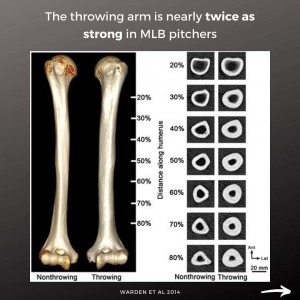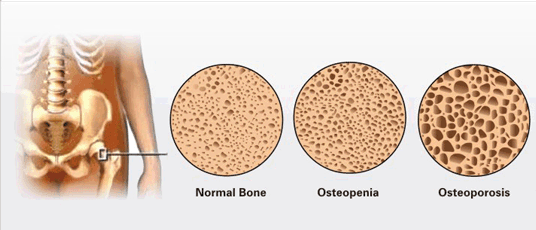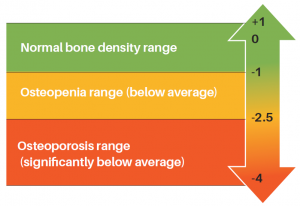12 Nov Are you looking after your bone health?
Why is bone health important?
Bone is a dynamic tissue that is continually being built, broken down and rebuilt as part of a normal metabolic process called bone remodelling.
Bone remodelling involves resorption (breaking down of old bone or the removal of micro-damaged cells) and formation (building new bone). This dynamic nature of bone is commonly underappreciated. Just like muscles, bone can change properties and adapt to training ie. what type of stress/load we put through bones. For example, check out the difference between the bone thickness in a baseball pitcher’s throwing arm compared to their non-throwing arm:

Bone strength is an important component of overall health, particularly as we age. From the age of ~30 onwards, there is a gradual loss of bone mass throughout the lifespan which accelerates into older age. This is because the balance between bone resorption and bone formation is skewed toward excessive resorption, this simply means that we don’t build enough new bone to replace bone that is being broken down. While this is a painless process, over the long-term bones weaken (osteopenia) and become brittle and prone to fracture (osteoporosis).
This process can be considered on a continuum, as shown below:

How do check my bone health?
The most common way of checking the health of your bones is having a bone density scan (DEXA or DXA scan), which can organised by your GP. This scan measures your bone mineral density and usually gives you a T-score, comparing how much your bone density is higher or lower than the bone density of a healthy 30 year old. This is useful in determining your risk of developing bone fractures and whether you should be making significant changes to manage your bone health.

How do I improve my bone health?
Bone remodelling is influenced by numerous factors:
- Nutrition
- Calcium and protein intake can lead to increased bone density
- Hormones
- Post-menopausal women (reduced oestrogen) are at increased risk of reduced bone strength
- Genetics
- People of Caucasian and Asian decent are at increased risk
- Lifestyle
- Smoking, alcohol consumption and minimal exercise history can reduce bone strength
- Load
- The forces imparted on bone through exercise can stimulate bone growth
Unfortunately some of these factors we cannot change, however nutrition, lifestyle and load we do have control of and can make significant changes to. Of these factors, load (exercise) has the greatest effect on bone strength. Correct exercise can maintain or improve bone density. Bones will become stronger when a certain amount of impact or extra strain is placed on then. Exercise-induced strain generates microscopic damage in bone which stimulates targeted remodelling.
What kind of exercise is effective for bone remodelling?
Exercise must be regular and ongoing to have a proper benefit. The effects of exercise on bone depend on three main factors:
- Type of exercise
- Aerobic training (e.g. swimming, cycling, walking) is NOT enough to stimulate bone remodelling
- Dose of exercise
- Short bouts of loading separated by periods of rest are better than continuous loading
- Force should be applied rapidly
- Loads should be diverse as adding variety can stimulate additional bone adaptation
- Intensity of exercise
- Must induce relatively high levels of bone strain (e.g. weight training)
Strength training and weight-bearing impact exercise such as hopping/jumping can be combined in a program to help maintain or improve bone mass. Athletes in high-impact sports such as gymnastics, volleyball, basketball, football, ballet dancing, powerlifting and tennis have consistently demonstrated higher bone mass compared to athletes in non-weight bearing sports.
It is important to note that the quality of bone, not just the density, is important for bone strength and minimising fracture risk. This refers to the size, structure and intrinsic properties of bone which facilitate it’s characteristic lightweight and strong nature. Therefore, imparting a variety of forces on bone is important to optimise bone quality. This is particularly important in kids and adolescents as they are growing.
For more information and tips on bone health, check out Osteoporosis Australia https://www.osteoporosis.org.au/
Want to learn more? Check out these other blogs:
References:
https://www.iofbonehealth.org/pathophysiology-biological-causes-osteoporosis
Brukner, P., Clarsen, B., Cook, J., Cools, A., Crossley, K., Hutchinson, M., … & Khan, K. (2017). Clinical Sports Medicine, Volume 1, Injuries. Chapter 4. Australia: McGraw-Hill Education.


